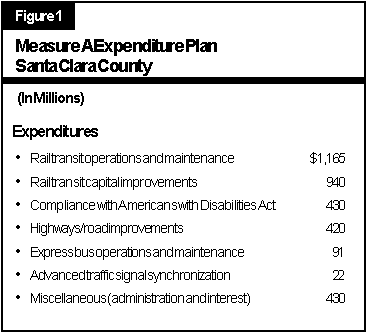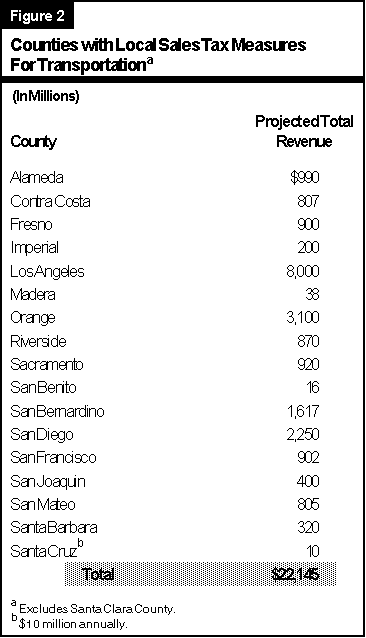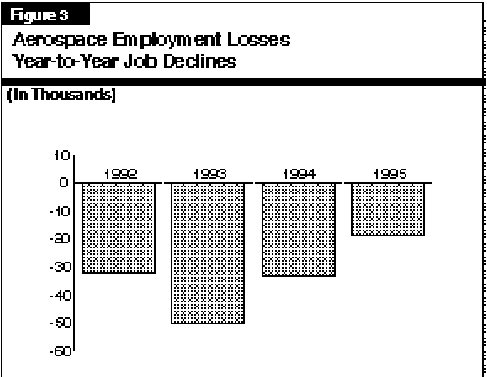

On September 28, the California Supreme Court overturned earlier Court of Appeal cases and upheld Proposition 62's voter approval requirements for local taxes. Proposition 62, an initiative adopted by the voters in 1986, prohibits a local agency from imposing (1) a tax for specific purposes (a "special tax") unless it is approved by two-thirds of the voters or (2) a tax for general purposes (a "general tax") unless it is approved by a majority of the voters. This Supreme Court decision, Santa Clara County Local Transportation Authority v. Guardino, has important implications for Santa Clara County, 17 other transportation financing agencies, and many California cities and counties.
In November 1992, Santa Clara County voters approved by a 54.1 percent majority "Measure A," a one-half cent sales tax for transportation purposes. Measure A would have raised about $3.5 billion over 20 years, with the money used primarily to fund improvements and operation of the rail system in the county, as shown in Figure 1. The Supreme Court ruled that Santa Clara's tax was not valid because this tax did not receive two-thirds voter approval as required by Proposition 62.

What Can Santa Clara County Do Next? In order to fund some or all of the planned projects given the court decision, Santa Clara County could attempt to secure two-thirds voter approval for another local tax measure in 1996. Alternatively, the county could substitute higher priority Measure A projects for some of the county's projects currently scheduled to be funded in the 1994 State Transportation Improvement Program. This approach, however, would not provide more money for county projects, but would instead entail a reprioritization of projects, presumably according to their deliverability and their effectiveness in reducing congestion for the area.
Currently, 17 other counties levy at least one one-half cent local sales tax for transportation purposes. In all except two counties (Riverside and San Benito), the tax was approved by a majority, not a two-thirds, vote. Figure 2 shows these 17 counties with increased sales taxes for transportation and the amount of revenues projected to be generated.
Generally, these sales tax measures range from 10 to 20 years in duration. Together, they are projected to generate about $22.1 billion. The monies will be spent for a variety of highways, roads and streets, and transit (including rail) improvements. According to the expenditure plans which designate how these sales tax revenues will be used, about one-third of all projected revenues will be spent on state highways, about 43 percent on rail transit systems and the remainder for local roads and other transportation purposes.

Are These Other Transportation Tax Measures in Jeopardy? Whether similar tax measures in the other counties might be affected in the short run by the State Supreme Court decision is unknown. However, unlike Measure A which was challenged shortly after the 1992 election, all existing measures were in force prior to 1991, and the time periods for legal challenge as provided in each measure (typically six months after their adoption by voters) have expired. Additionally, in many of the counties, these tax revenues already have been obligated for project construction, or bonds backed by the projected revenue streams have been issued to fund project construction.
In the long run, as the existing measures expire, any future extension wold require two-thirds voter approval as a result of this decision. Based on experience to date, it appears that it would make it more difficult for local governments to raise funds to supplement state and federal money for transportation improvements.
Relying upon earlier Court of Appeal opinions on Proposition 62, many California cities and counties imposed general taxes in recent years without submitting the tax to a vote of the electorate. Statewide, these general taxes (typically, utility, business, and hotel taxes) generate at least tens of millions of dollars annually.
Will the Decision Affect Existing City and County Revenues? There is considerable uncertainty regarding the impact of this decision upon California's cities and counties. Because the court opinion did not discuss implementation matters, city and county officials are not certain whether they must repeal--or refund--non-voter-approved taxes, or whether these existing taxes may be maintained. In addition, many legal experts argue that charter cities (such as Los Angeles, San Diego, and San Francisco) are exempt from Proposition 62's voter approval requirements because a statutory initiative may not restrict a charter city's taxation powers. These uncertainties may be resolved in future litigation.
Contacts--Dana Curry (transportation issues)--(916) 324-5921
Marianne O'Malley (city and county issues)--(916) 445-6442
Recent developments suggest that the trend in state General Fund revenues is exceeding the budget forecast. Collections in September were up $403 million, bringing total receipts for the first three months of this fiscal year to $525 million above projections.
While as much as $125 million of the year-to-date gain is due to cash-flow factors, the remaining $400 million increase appears to be permanent. The increase is encouraging because it is from sources which are closely linked to current economic activity. For example, withholding payments, which reflect California employment and wages, were up nearly 8 percent from the prior year in the July-through-September period. Bank and corporation estimated taxes, which are related to current profit trends, were up over 13 percent during the same period. These gains, coupled with better-than-expected growth in employment and personal income, indicate that California's economy is presently stronger than the budget forecast had anticipated.
California's improved performance over the past year reflects rising sales, profitability and job gains in a variety of industries, including computers, electronics, software development, wholesale trade (which includes import-export firms), business services, tourism, and construction.
The weakest industry sector has been finance, insurance, and real estate, which continues to undergo major consolidations and restructurings. Job losses also occurred in aerospace industries, however at a much more subdued rate than in past years, as shown in Figure 3. These more modest losses imply that defense-related reductions are becoming less of a drag on overall California economic growth. This is particularly evident in the more positive job performances in Los Angeles, Orange, and Santa Clara Counties, which had been harshly affected by cutbacks in defense contract spending in previous years.

Contact--Brad Williams--(916) 324-4942